I first time I saw this snake was when it fell out of a grapevine over our back deck. I was sweeping the deck and it fell on the deck right beside me, much to my surprise, its surprise and the surprise of our two dogs.
Snakes aren’t supposed to fall like that, I thought as I told the dogs to leave it and I reflexively swept it off the edge of the deck. To my even bigger surprise it immediately climbed back up one of the supporting poles as if to get back onto the deck. These snakes are incredibly agile climbers, able to climb relatively smooth surfaces such as a pole.
You are supposed to be scared of me, I thought sweeping it off again, only to have it climb back up again. This time I left it to climb back up, as it dawned on me: I am probably a most familiar sight to the snake. For all I knew, it had lived unobserved in the vine for months if not years. So it climbed up past me and up high into the vine, a familiar and safe place.
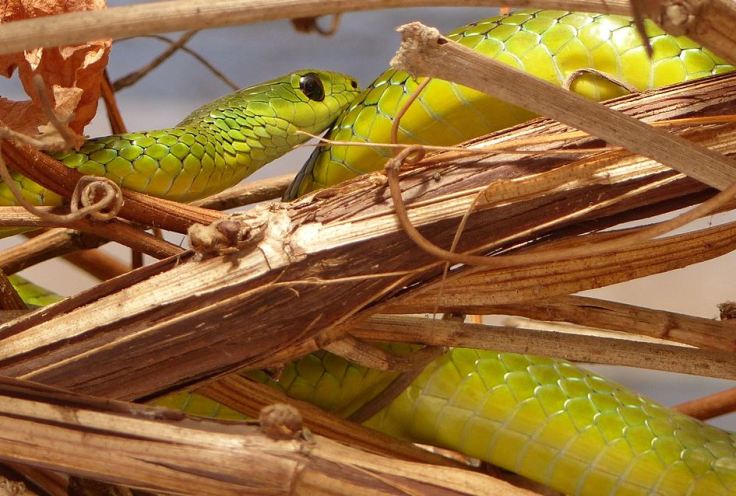
Of course I did not feel the same about sitting under the grapevine after that, and neither did one of our dogs, who became adept at alerting me to whenever the snake was present.
One of the several species of Green Snakes, the Natal Green Snake in our garden, is harmless to humans. It has no fangs and it is not venomous, although The Guide to Reptiles in Southern Africa reports that its saliva has been shown to be toxic, “but not dangerously so to humans”. The Natal Green Snake, like other green snakes hunts during the day. It has excellent vision and its large dark eyes have a coppery ring around the iris – and this is one of its features that distinguishes it from the poisonous Green Mambas and Boomslangs. Unfortunately, it is often killed by people fearing it is a poisonous snake.
Green snakes in general are long and slender and very beautiful. They can be up to one metre in length. Their graceful climbing is quite something to see. Their prey includes frogs, chameleons, geckos, nestling birds, fish and insects. The Green Water Snake occurs mostly near water where it can prey on fish.
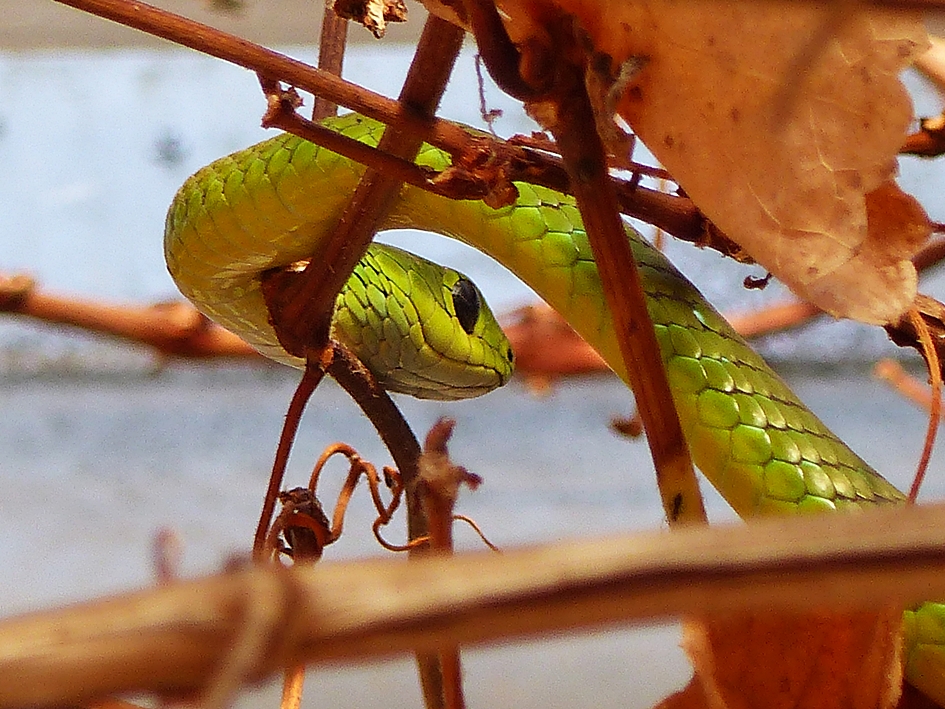
This individual snake is at least a metre in length. At the time these photos were taken, it lived in the roof of our house, which we accepted – and so did the dogs!
Rather than me taming the snake, the snake tamed me. At first I only photographed it through a closed window. As I became tamer, I photographed from the ground while it watched me from the vine above.
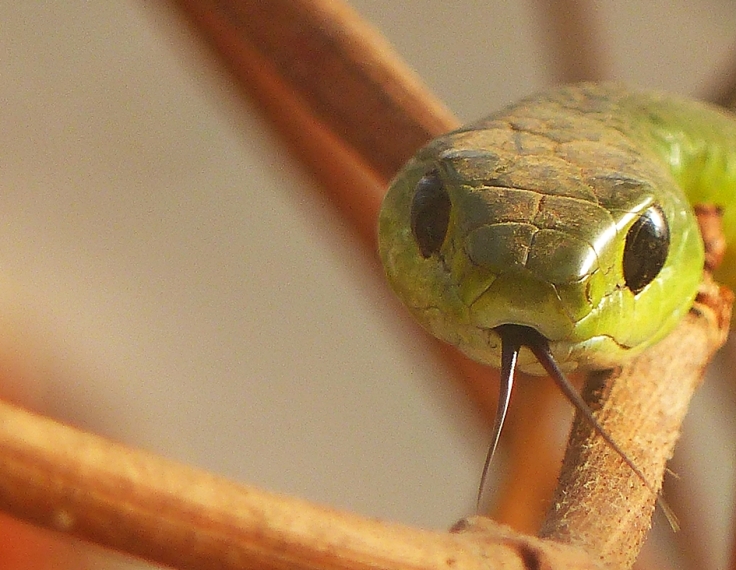
The Western Natal Green Snake, watching me while picking up scent particles when flickering its tongue. The tongue is withdrawn into the mouth and the particles transferred to a chemo-receptor in the roof of the mouth.
To make certain that we had identified the snake correctly , I emailed some photos to Johan Marais, snake expert and co-author of The Guide to Reptiles in Southern Africa. He was kind enough to respond and confirmed that it is a Natal Green Snake. There are two subspecies, and he noted that in our area the Western form and not the Eastern form occurs.
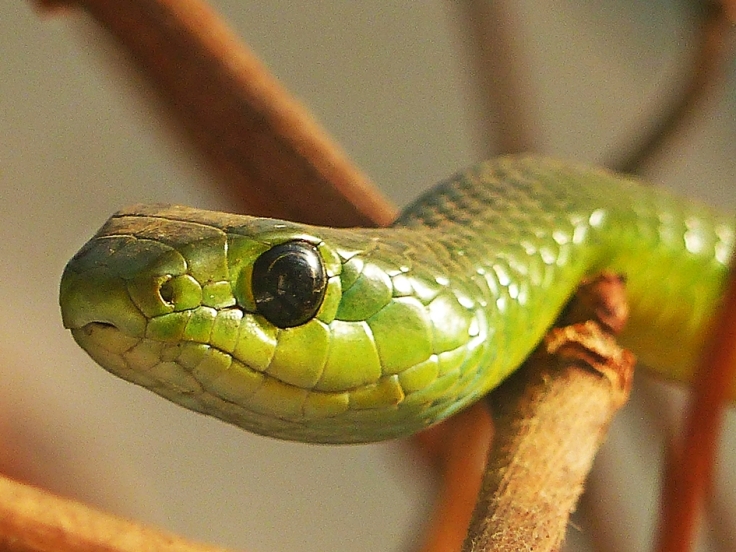
So the snake and I tolerated each other, but unfortunately, I unintentionally overstepped the bounds of this relationship.
One day, one of our dogs alerted me the snake’s presence. I went out to see it and to calm the dogs and tell them to leave the snake. At first I was confused, until I worked out there were actually two snakes on the wooden latte roof adjacent to the grapevine trellis. It turned out that that they were a courting couple.
I thought it would be an interesting encounter to photograph. I fetched an A-frame wooden ladder, climbed up and tottered rather precariously trying to take some pics at a distance of about 4 metres away from of the snakes, even though the light was quite low.
Well, the one snake did not take kindly to this. Perhaps it was the visiting snake, unaccustomed to my presence, or perhaps it was having me above ground level that upset it. Or maybe even snakes like to be private when being intimate? Anyway, one of the snakes lifted its head and moved swiftly and aggressively across the latte roof towards me. I went down the ladder as fast as my legs would take me!
I moved the ladder a further two metres away and climbed back up to see that the snakes were back together, but then the one moved to the side of the roof and hung down from it and stared at me. I got the message, and feeling most contrite, I packed up the ladder and left them to it.

However, the harm was done, and we did not see the snake in the grapevine again.
However, about 18 months after that, I saw a youngster moving on its way to somewhere else past the grapevine. Perhaps one of the offspring of the pair I saw? And only today, in our spring garden, hanging from a tree, we saw the shed skin of a long slender snake, most likely a Natal Green Snake, so they are still around, just living more discretely than before.
So there are two take-home messages here.
Snakes can make peaceable neighbours and most snakes are not poisonous and most snakes would rather retreat than attack. If worried about a snake in your garden contact a snake expert who may be able to relocate the snake rather than kill it. For a list snake experts (mostly in Southern Africa and Africa), supplied by the African Snakebite Institute, who can assist with snake removal (some will charge a fee for this service) click here
Secondly, the camera is not an intermediary between oneself and a wild animal, and so the desire to take a picture should not tempt one to behave in a way one would not without a camera. I need to be more mindful of this and respect the needs of wildlife first and place any wish to take a picture second.
Anyone who has visited a busy game reserve must have observed what I call “combat game viewing”. Sadly, it is usually photographers who are the most combative, all too often intruding too close to animals, interrupting their behaviour, and having no qualms about obscuring the view of other visitors.
Posted by Carol at letting nature back in
Source: Alexander, Graham & Marais, Johan. 2007. A Guide to the Reptiles of Southern Africa. Cape Town: Struik Nature.

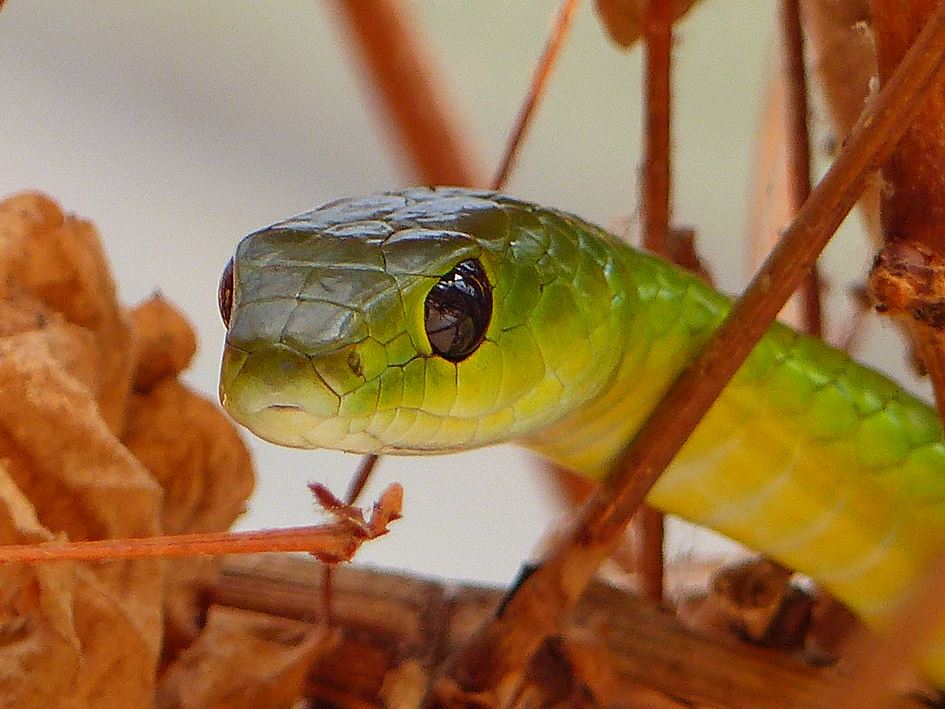







June 9, 2017 at 1:50 am
She is a beauty. Those eyes! I love critters, but my twin would chase me around the house with snakes when we were little. They still give me goose bumps!
LikeLike
June 9, 2017 at 7:14 am
It is a lovely creature and unexpectedly agile too.
LikeLiked by 1 person
December 25, 2016 at 8:14 am
A lovely thoughtful story and exceptionally beautiful photos. A real privilege to be able to observe this snake so closely.
LikeLike
December 27, 2016 at 6:11 am
A real privilege indeed. Thanks Nikki.
LikeLike
November 21, 2016 at 4:51 am
What a pity the snake(s) moved. You are probably right about the reasons for doing so. We used to ‘rescue’ snakes from gardens in the neighbourhood and release them in our own – until there were babies next door and we had to go further afield. Now when I see a snake I am delighted that at least there will be one rodent less to worry about and keep quiet. Most urban dwellers are fearful of snakes and don’t give them half a chance. Snake visitors here are mostly puffadders and green bush snakes.
LikeLike
November 21, 2016 at 5:18 am
In fact it seemed it didn’t move far. Just to our garage roof, and I have seen one of the same size hunting frogs. Frogs are more common in our garden than rodents. Great that you rescue snakes and supply a refuge for them. We also have other snakes around, but apart from one blatant sunbathing day for our resident mole snake, they keep a low profile.
LikeLiked by 1 person
November 20, 2016 at 10:40 pm
I like what you said. We do need to be respectful of wildlife. Lovely photos.
LikeLike
November 21, 2016 at 5:08 am
Thanks Sherry. I am a great believer in respect. Something to aspire to anyways.
LikeLiked by 1 person
November 20, 2016 at 9:52 pm
Interesting background and terrific photos!
LikeLike
November 21, 2016 at 5:05 am
Thanks Belinda.
LikeLiked by 1 person
November 20, 2016 at 8:52 pm
Great shots! 🙂 I love snakes (and all wildlife creatures)!
LikeLike
November 21, 2016 at 5:04 am
Thanks Tom. Generally, snakes get a particularly bad response from humans and so need all the support they can get.
LikeLike